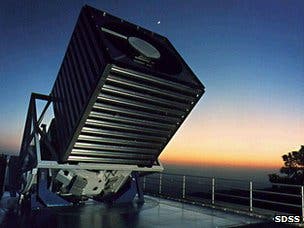
Encompassing years worth of work, the Sloan Digital Sky Survey (SDSS-III) has now precisely measured the distance between over a quarter of a million galaxies. As part of the project, called the Baryon Oscillation Spectroscopic Survey, or BOSS, scientists built a massive map of all the studied galaxies so far, some more than six billion years ago – a period that marks a tipping point in the Universe’s history. Around this time, matter became so spread out that gravity wasn’t enough to slow down the Universe’s attraction, and instead dark energy took over causing the Universe to begin an accelerated expansion process which continues to this day. Dark energy is still a huge mystery even to the most enlightened astrophysicists, however what makes the Baryon Oscillation Spectroscopic Survey extremely exciting so far is that it confirms the theoretical models proposed.
Scientists claim that dark energy accounts for 73% of all the mass-energy in the universe. That’s a massive proportion, considering that dark energy is still just that thing, expressed in cosmological constants in mathematical models. Understanding dark energy, thus, becomes a key prerequisite to holistically understanding the Universe.
“There’s been a lot of talk about using galaxy maps to find out what’s causing accelerating expansion,” says David Schlegel of the Lawrence Berkeley National Laboratory.
“We’ve been making a map, and now we’re using it – starting to push our knowledge out to the distances when dark energy turned on.
The BOSS project was centered around the fascinating baryon acoustic oscillations. These sound waves were emitted some 30,000 years after the Big Bang and then continued to oscillated throughout for some 350,000 years, when the Universe cooled down and hampered their propagation. Matter clustered around the center and edges of the wave, basically guiding galaxies to form in those areas.
The Sloan Digital Sky Survey found that these galaxies were found to be almost at the exact location predicted by the model, helping scientists measure how fast the Universe was expanding six billion years ago, to an accuracy of two percent.
Besides providing highly accurate measurements of the distances between galaxies, the BOSS also serves as a great experiment for testing Einstein’s Theory of Relativity.
“Since gravity attracts, galaxies at the edges of galaxy clusters fall in toward the centres of the clusters,” says Beth Reid, a NASA Hubble Fellow at Lawrence Berkeley National Laboratory.
“General Relativity predicts just how fast they should be falling. If our understanding of General Relativity is incomplete, we should be able to tell from the shapes we see in BOSS’s maps near known galaxy clusters.”
The rate at which galaxies fall into clusters, however, is well consistent with Einstein’s predictions, thus providing another sound proof debunking General Relativity naysayers.
“We already knew that the predictions of General Relativity are extremely accurate for distances within the solar system,” says Reid, “and now we can say that they are accurate for distances of 100 million light-years.
We’re looking a billion times further away than Einstein looked when he tested his theory, but it still seems to work.”
The survey is still a long way from being finished, as only a third of it was completed thus far. As scientists map the Universe at an even greater scale and dwell deeper, billions of light years farther, the Universe’s secrets will come closer to becoming unraveled.
The findings were published in the journal Cosmology and Extragalactic Astrophysics.
[via io9]






